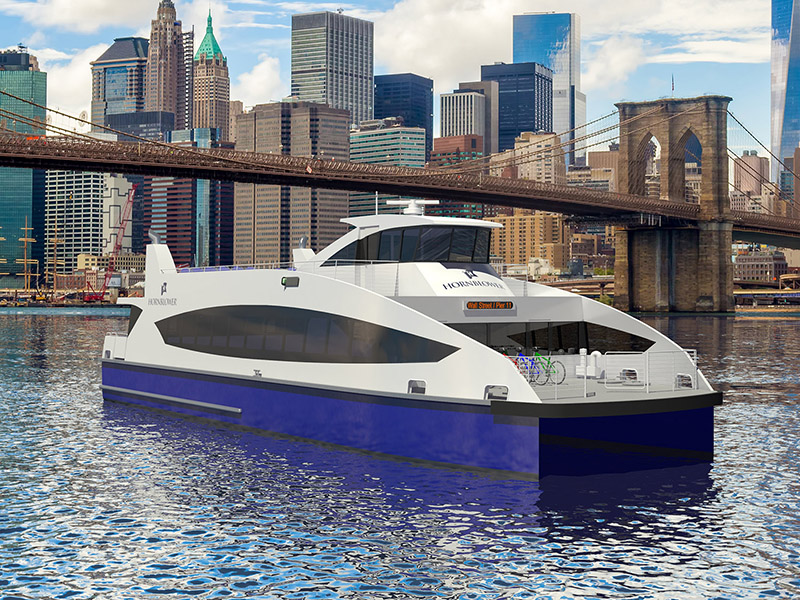Diversity of workmanship on New York's new ferries matches the city they will serve
Transparent collaboration on vessel engineering and manufacturing, and diesels with low air emissions and high reliability helped convince operators of the New York Citywide Ferry System to look to the Gulf Coast – and the south of France – for their fleet of 19 aluminum catamarans.
Proposals from a dozen shipyards and multiple engine options were explored before the decision was made to go with Horizon Shipbuilding, Inc., and Metal Shark to build the vessels, and Moteurs Baudouin for engines, said Cameron Clark, vice president and general manager of Hornblower New York.
“Most of the yards could meet schedule...the timelines weren’t that different,” said Clark, who oversees HNY Ferry Fleet LLC, operator of the new public ferry and a subsidiary of San Francisco-based Hornblower Cruises & Events.
Hornblower officials were impressed not only by Horizon's and Metal Shark's abilities for fast turnaround, but also their openness to “changing their manufacturing methods…kind of re-think how you build boats,” Clark said.

Cameron Clark, vice president and general manager of Hornblower New York.
The first Incat Crowther-designed 85’4”x26’3” catamarans, built to carry up to 149 passengers at service speeds of 25 knots, are to be delivered by spring 2017. The Citywide Ferry, offering subsidized one-way fares of $2.75, is scheduled be running next summer.
Hornblower and its selected team of designers and builders had been working closely together for months before Mayor Bill de Blasio’s office and the city Economic Development Corporation formally announced the contracts July 8. That high level of collaboration is continuing throughout the construction process, Clark said.
Clark said part of that is Horizon’s proprietary Gordhead management software that allows shipbuilders and clients to work closely during the construction process.
For Horizon’s workforce, Gordhead software shares “drawings, specifications, schedules and other necessary information with Horizon’s production leaders and in turn with the craft building the vessels,” according to company literature. “Each production leader carries a ruggedized wireless computer pad that allows them to stay connected to their project at all times. They are able to pull up the latest revisions of drawings, read the contract specifications, order necessary material, review the project schedule…pretty much anything the project requires; all while being at their work site on the boat.”
Along with communicating between all from the craftsmen up to Horizon president Travis Short, the web-based system lets customers far from the shipyard track construction progress in real time, and includes them in discussions and production processes.
Incat Crowther’s Gulf Coast representatives will be at Horizon in Bayou LaBatre, Ala., and Metal Shark’s expanded 25-acre facility in Franklin, La., while designer Brett Crowther and the home office team connect online from Australia, Clark said.
“They’ve got boots on the ground in the region and are part of the process,” he said.
“They make marine engines. They don’t make truck engines, they don’t make crane engines.”

The Baudouin M26.3 engine.
For propulsion power, “we wanted to have the most fuel-efficient engines,” with good power-to-weight ratio and very low air emissions, Clark said. Hornblower’s in-house engine experts set to research – “We sent out our Cat (Caterpillar) lovers, we sent out our MAN lovers,” Clark said.
The team took a look at Baudouin, a century-old marine engine manufacturer based near Cassis, a French fishing port on the Mediterranean, distributed and serviced in North America by Motor-Services Hugo Stamp, Inc., Fort Lauderdale, Fla.
“They make marine engines. They don’t make truck engines, they don’t make crane engines,” Clark said of Baudouin. The company’s M26.3 engine line meets EPA Tier 3 emissions standards, and will be easily serviceable in the boats, Clark said.
As part of the deal Baudouin will both provide technical support and train Hornblower’s own engine technicians working at the company’s Brooklyn Navy Yard homeport.
“Our team is to be qualified as the first and hopefully last line of defense,” with annual training updates and re-certifications, Clark said. Those will probably be about a dozen positions out of 150 the company conservatively foresees as new hires, including welders, fabricators and joiners among the craft trades.
The Economic Development Corporation is working on the homeport design for the Navy Yard, expected to be unveiled in coming weeks. A big part of the plans is for “resiliency;” the ability to survive a major disaster like Hurricane Sandy in 2012, and keep the fleet operating. The Citywide Ferry Service will be a key piece of emergency management planning for the city, using lessons learned from the Sept. 11, 2001 evacuation of lower Manhattan and other events when ferries played a major role.
The partnership with city agencies “shows a model how an operator can come in and build a turnkey system,” Clark said. “Our goal would be to demonstrate over time here in New York how we can come in and do this in other cities at a cost-effective time frame.”





